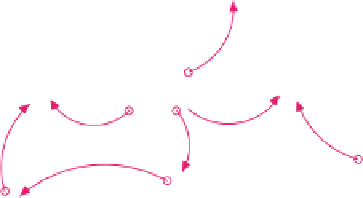Database Reference
In-Depth Information
13.1 Basic Disease Model with Chaos
13.1.1 Model Set-up
Assume the size of the sick population affects its awareness about a disease
(Figure 13.1) and thus its behaviors and rate at which individuals in the popu-
lation become contagious (Figure 13.2). GETTING SICK is the product of the
CONTAGION RATE and the stock of SICK people. GETTING WELL, similarly,
is a function of a “sick time coefficient” and the stock. However, to allow for the
emergence of chaos, we have specified the relationship as a nonlinear equation:
SICK
∧
2
GETTING WELL
=
/
SICK TIME COEFF
(13.1)
Running the model with a CONTAGION RATE as in Figure 13.2, but setting
the maximum value to .2 instead of 2 yields the results shown in Figure 13.3. The
number of sick initially increases and comes to a steady state. Changing the maxi-
mum CONTAGION RATE to 1.2 can lead to an initial overshoot and ultimate steady
state (Figure 13.4). Increasing the CONTAGION RATE maximum further (and/or
giving your curve of Figure 13.2 more curvature) can yield periodic oscillations
(Figure 13.5) and ultimately chaos (Figure 13.6). The results in Figure 13.6 are de-
rived for the relationship between AWARENESS LEVEL and CONTAGION RATE
of Figure 13.2.
While the chaotic time path of Figure 13.6 does not show any order—no pattern
repetitions are seen in the behavior of our state variable—a neat relationship exists
nonetheless between the values of the state variable at any given period of time
and the value it took on a DT earlier. This relationship is shown in Figure 13.7,
and emergence of the pattern depicted there can be used as a heuristic means when
trying to detect chaos.
LAG SICK
SICK
GETTING WELL
GETTING SICK
SICK TIME COEFF
~
CONTAGION RATE
AWARENESS LEVEL
Fig. 13.1









